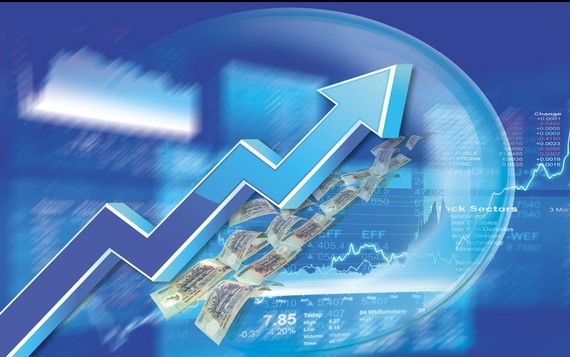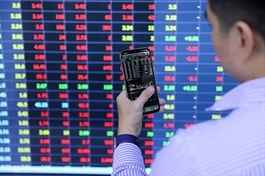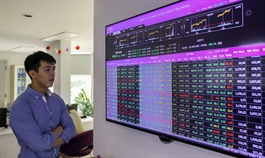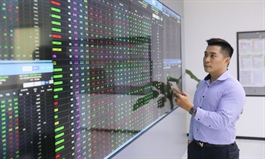Stock market overwhelmed by new investors
Stock market overwhelmed by new investors
The sudden outbreak of the fourth wave of the Covid-19 pandemic caused GDP growth rate to be negative for the first time at minus 6.17% in the third quarter of 2021.
Ilustrative photo. |
However, the stock market surprised all by surpassing to new historical heights. There was more cash flow in the stock market in the first ten months of 2021, far exceeding that in 2020. As per an outside investment fund, cash flow is increasing spectacularly, as investors wait for an even bigger economic stimulus package.
Cause of cash flow
Post Covid-19 pandemic recovery and stimulus measures have been under deployment around the world since 2020. Always accompanying these stimulus packages is a loosening monetary policy, which the stock market expects. This is also the source of fear of asset bubbles due to flood of cheap money. For Vietnam's stock market, the so-called tsunami in 2020 has not shown any signs of cooling down from the beginning of 2021 until now. The VN-Index has grown by 32.72%, and since the peak of the pandemic, it has grown by 121.22%. Hence, it is not surprising that a stimulus package worth nearly USD 35 bn has raised concerns of exaggeration more than the risk of an assets bubble.
According to an assessment of the interaction between economic support measures and cash flow in the Vietnamese stock market, the growth momentum of securities is not associated with direct support measures. In 2020, the support packages were mainly indirect through loan rescheduling, tax reduction, and cash support for disadvantaged people. Unlike other countries in the world, especially the US, the beneficiaries of direct cash support have little connection with securities investment activities. Therefore, the main factor promoting cash flow related to securities is very low-interest rates, and stimulating the middle class with idle money to switch to securities investment channels.
Banks themselves have helped by devising all kinds of investment services to hold onto depositors, as well as vying for advantage of demand deposit rate (CASA). Flexible investment packages in bonds, fund certificates, or securities investments through the bank securities company, still keep money connected between securities accounts and savings accounts. This has stimulated a huge source of capital that has long been dormant in accounts enjoying demand interest rates, or cheap short-term savings interest rates. This source of money is much larger than any economic stimulus package.
The evidence is that a number of securities trading accounts of domestic individual investors has increased dramatically. In the first ten months of 2021 alone, nearly 1.09 million new accounts of this type were opened, nearly 2.8 times the number in 2020, which was also a historic record. Even in ten months of this year, the number of domestic individual investors jumping into the stock market is more than in the last four years combined. If on an average, each account deposited VND 100 mn, the figure is nearly VND 109,000 bn. If each account has an average of VND 1 bn, it will be a huge number that has just been added to the market in less than one year. This is not to mention that for every billion Vietnam dong of capital, you can borrow half more according to current regulations.
Risk speculation
The risk is that the source of cheap money is too large on the stock market and that it will inflate the asset price more than it is real. However, a bubble risk needs to be looked at from two angles. First, the source of money contributing to that bubble is how much in equity capital and how much in borrowed capital. Second, a bubble must be accompanied by an unreasonably high valuation, which means that the underlying value of the business escapes due to excessive speculative demand.
Currently, the source of money in the lending market comes mainly from banking channels and the equity capital of securities companies. This is a source of money that can be controlled by tools, especially after painful lessons learnt during the period 2007 to 2008. However, the main source of money is still hundreds of thousands of new accounts opening every month. By the end of October 2021, the total number of individual investor accounts in the country were at 3.81 million, equivalent to approximately 3.9% of the population. The target of restructuring the stock market and insurance market is towards 5% of the population by 2025. This means that the wave of individual investors participating in securities has grown faster than expected, and it is the mobilization of capital from the people into this capital channel.
Regarding the valuation factor, the business results in the third quarter of 2021, although decreased by about 19.7% compared to the second quarter of 2021, still grew by 14.7% over the same period, according to FiinTrade calculation. This is quite a surprise because in the third quarter social distancing was prolonged, but corporate profits were still positive. This makes the valuation coefficient P/E of the Vietnamese stock market forecast to be about 18.2 times by the end of 2021.
However, 2022 will likely be the year of economic recovery and strong growth for Vietnam. Corporate profit in 2020 may grow 27% compared to 2021, which is expected to reduce P/E 2022 to 14.3 times with the current score as seen until 21 October. This means that in relation to the growth rate of corporate profits, in the next two to three years, the valuation of Vietnamese securities will not be at the bubble threshold, if you look at Vietnam's P/E Index at the time of the bubble in the second quarter of 2007 to 34 times.
However, the remaining risk is that the long-term maintenance of too low-interest rates combined with the USD 35 bn economic stimulus package, if not closely monitored for the purpose of capital use, can increase the source of opportunity capital on the stock market. The period of 4% interest rate support in 2009 was a lesson when money did not enter production and businesses, but flowed into property speculation from securities to real estate, leading to long lasting consequences.
Liquidity on stock market increased in proportion to number of new domestic individual investor accounts. This shows that the stock market is attracting idle cash flow from the population, and not just speculative capital flow from the banking system as in the 2007 to 2008 period.


























